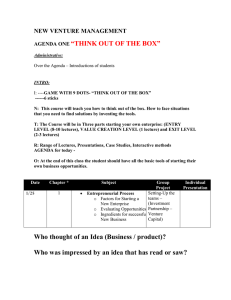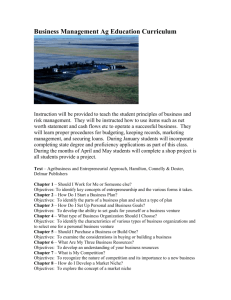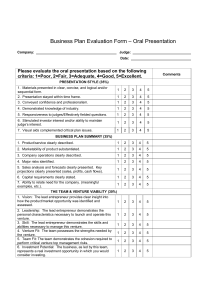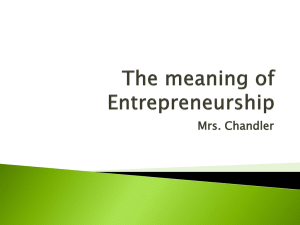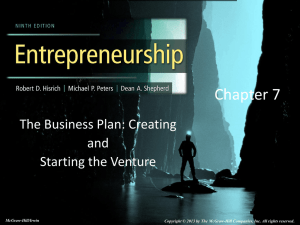Concept development (classnotes from chapter 9 of Venture
advertisement
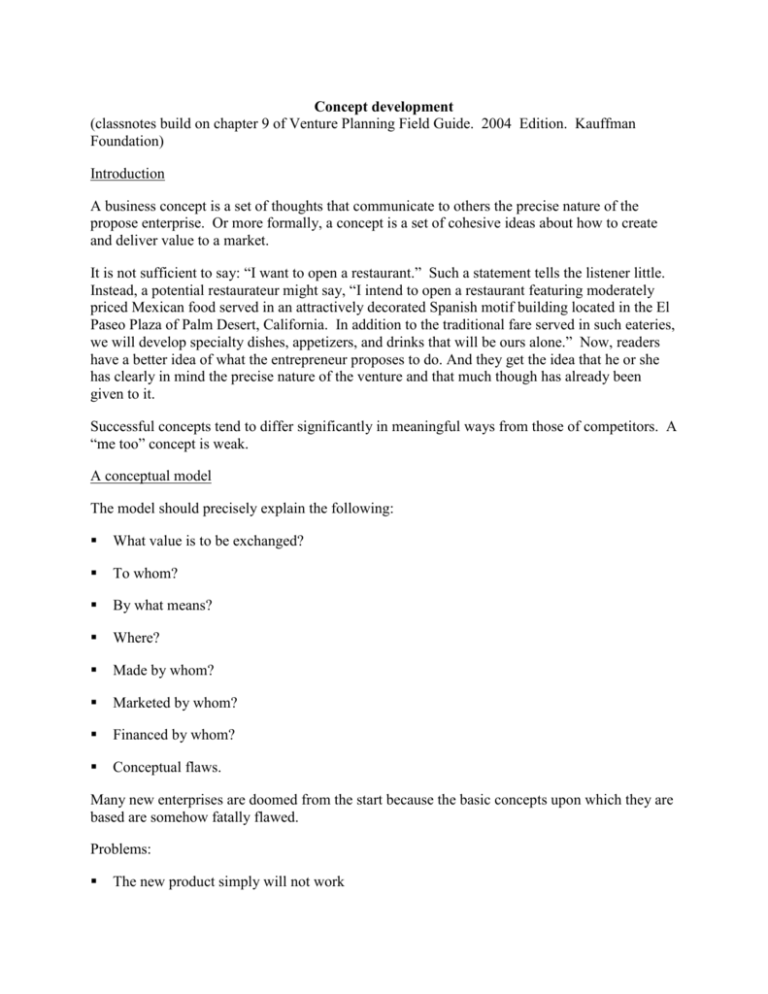
Concept development (classnotes build on chapter 9 of Venture Planning Field Guide. 2004 Edition. Kauffman Foundation) Introduction A business concept is a set of thoughts that communicate to others the precise nature of the propose enterprise. Or more formally, a concept is a set of cohesive ideas about how to create and deliver value to a market. It is not sufficient to say: “I want to open a restaurant.” Such a statement tells the listener little. Instead, a potential restaurateur might say, “I intend to open a restaurant featuring moderately priced Mexican food served in an attractively decorated Spanish motif building located in the El Paseo Plaza of Palm Desert, California. In addition to the traditional fare served in such eateries, we will develop specialty dishes, appetizers, and drinks that will be ours alone.” Now, readers have a better idea of what the entrepreneur proposes to do. And they get the idea that he or she has clearly in mind the precise nature of the venture and that much though has already been given to it. Successful concepts tend to differ significantly in meaningful ways from those of competitors. A “me too” concept is weak. A conceptual model The model should precisely explain the following: What value is to be exchanged? To whom? By what means? Where? Made by whom? Marketed by whom? Financed by whom? Conceptual flaws. Many new enterprises are doomed from the start because the basic concepts upon which they are based are somehow fatally flawed. Problems: The new product simply will not work No real need: Business fail when they don’t fill some need perceived by enough people to make operations profitable. Hidden traps: A product may threaten the career of the person who is supposed to buy it— Always assess the intended customer’s reaction to the concept. Most hidden traps lie in the minds of the intended customers, but not always, sometimes they are physical. For example a line of 12 plastic disks called Astro Wheels encountered great difficulty obtaining distribution in the retail outlets it needed (supermarkets, drug stores, and gift shows), because the size of the disks required that they be hung on a wire rack that simply did not fit comfortably in those stores. “It just isn’t worth the bother” was an often heard comment. Unfortunate economics. The cost of some concepts is just so high that they won’t pay enough to make the venture profitable. No protection. Some concepts, if proven sound, can be easily copied by other organizations capable of quickly exploiting the market, perhaps driving the entrepreneur from it. Note that, sometimes, a venture’s protection lies in the smallness of its market niche; it can make money serving some small segment of the market while larger firms cannot. Obsolescence. Many concepts are so faddish that an enterprise based on them has only a few months to make its profits. Installation. Many concepts sound great until the realities of placing them into use are confronted. Customers don’t buy products or services, they buy benefits. They buy solutions to their problems, which are not solved until the concept is in place and working satisfactorily. Education. If the new product will be successful only after the customer has been educated watch out. Changing consumer behavior. A concept that requires a change in consumer behavior will be resisted unless the rewards are obviously sufficient to motivate the change in behavior. Assumptions. They are unavoidable but watch out some come be devastating: An entrepreneur may assume that the selected store locations can be properly zoned. If the locations cannot be zoned for the projected activity, then a new plan is needed. After identifying the assumptions, the entrepreneur should try to find information that validates them. Inconvenient. Legions of retailers have floundered when they assumed that their intended customers would go a little out of their way to patronize their out-of-the-way store (poor location) because of its superior offering, be it lower prices, assortment, or service. Service requirements. Logistical difficulties have ruined many concepts. Strong attributes of successful products Involves significant savings Solves serious problem Offers convenience Fits existing scheme of things Attracts media attention Clearly identifies market Captures a monopoly Joins a rapidly expanding market Promises a big upside; low downside Writing a concept The acid test for a well-defined concept statement is to hand it to a stranger and have him or her relate back precisely what the proposed business is. Even when the concept is clear, it will change over time s the entrepreneur learns more about the market and the economics of the new venture. The concept statement will be reviewed and modified as additional information is gathered from the answers to other questions presented in the planning process. The last section completed in a feasibility or business plan is the executive summary, and the concept statement becomes the basis for this section.

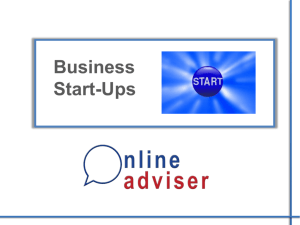
![Chapter 3 – Idea Generation [ENK]](http://s3.studylib.net/store/data/007787902_2-04482caa07789f8c953d1e8806ef5b0b-300x300.png)
